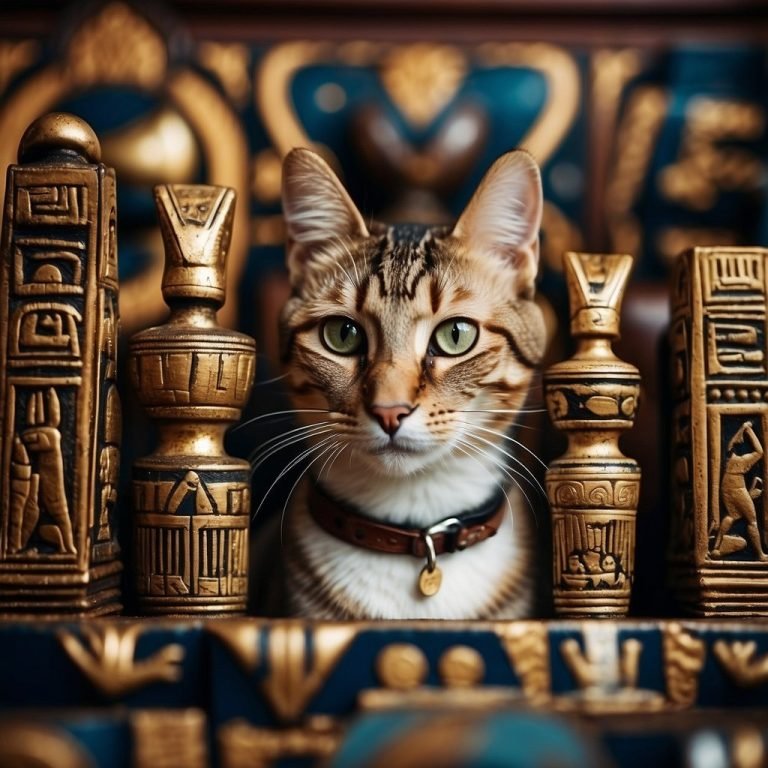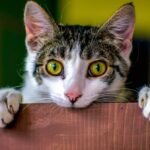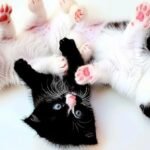How Felines Have Influenced Art Throughout History: Paws and Paintbrushes

Cats, with their enigmatic poise and captivating independence, have long served as muses for artists across the globe.
Your love for these furry companions is reflected in countless works of art spanning across civilizations and time periods.
From the ancient Egyptians, who venerated felines in their art, to the whimsically oversized sculptures of contemporary artists, the depiction of cats in art highlights humanity’s longstanding admiration for these animals.

These four-legged critters have not just lounged on our windowsills but have also prowled through the canvas of history, leaving paw prints on different artistic movements.
Cats have been portrayed in a variety of contexts, from symbols of domesticity and comfort to embodiments of mystery and sensuality.
This feline influence has led to some of the most charming and captivating artworks, which consistently draw the attention of cat lovers like you.
The creative world has embraced the sometimes playful, sometimes aloof nature of cats, weaving it into artistic expressions that resonate with many.
Whether they are the focal point of a painting or subtly included as part of a larger scene, cats have an undeniable presence.
The next time you gaze at a piece of art, notice how the artist may have captured the essence of our feline friends, showcasing the powerful influence of cats on human creativity.
Ancient Influences on Art
As a cat enthusiast, you’ll be delighted to discover the significant claw-marks felines have left on ancient art.
From deity representations to symbolic creatures, cats have been immortalized by various civilizations.
Egyptian Feline Deities and Art Forms
In ancient Egypt, cats were not only pets but sacred animals worshiped as deities.
The goddess Bastet, often depicted as a lioness or as a woman with a cat’s head, embodied protection, beauty, and fertility.
Egyptians created numerous sculptures and paintings celebrating cats, many of which have survived to this day.
They also mummified cats, which reflected their belief in these animals’ sanctity and their role in the afterlife.
Chinese and Japanese Artistic Interpretations
Moving East to ancient China and Japan, you’ll find that cats grace many forms of art including paintings and sculptures.
The legendary Japanese painter Utagawa Kuniyoshi was famous for his whimsical depictions of cats in the widely adored ukiyo-e woodblock prints.
The figure of the Maneki-neko, or beckoning cat, emerged as a symbol of good fortune – one paw raised inviting luck and prosperity.
Medieval and Renaissance Depictions
As you leap forward into the Medieval and Renaissance periods, you’ll see that European artists also integrated cats into their works, though often with different symbolisms.
In these periods, cats featured in manuscripts and paintings sometimes carried connotations of witchcraft or mystery.
Nevertheless, in Norse mythology, the goddess Freyja’s chariot is pulled by cats, highlighting their association with beauty and divine power.
🐱 Revel in these historical cat representations and consider the enduring impact these beloved creatures have had on human artistry through the ages.
Cultural and Artistic Symbolism

Cats captivate our curiosity, often carrying rich layers of symbolism through their storied existence in cultures worldwide.
They embody mystery and independence, and their roles in superstitions and folklore are equally fascinating and diverse.
Felines as Symbols of Mystery and Independence
Cats are celebrated for their poise and elusive nature, which has made them symbols of mystery and independence.
The Ancient Egyptians revered cats as sacred creatures, protectors, and symbols of grace and elegance.
They saw cats as guardians against evil, linking them to protection and good luck.
The gracefulness of felines has often been associated with various deities, as in Norse mythology, where the goddess Freyja‘s chariot is drawn by cats.
Superstitions and Folklore Surrounding Cats
In the tapestry of superstitions and folklore, cats have held a significant place.
They have been seen as omens of fortune or, conversely, bearers of evil.
Tales of witches and their cat familiars are threaded throughout Europe’s history, associating cats with witchcraft.
In Japanese legend, the bakeneko is a shape-shifting cat, often signifying the mysterious absorption of the spiritual into the earthly realm.
These beliefs and tales highlight the complex and often contradictory views of cats, capturing your imagination with their mystical presence.
Revolution in Arts: Cats in Modern Movements
Cats have clawed their way into the very fabric of modern art, making frequent appearances in works by acclaimed artists.
From the soft brushstrokes of Impressionism to the bold symmetry of Cubism, these furry muses have inspired an array of artistic styles.
Impressionism and Post-Impressionism
During the latter part of the 19th century, Impressionist and Post-Impressionist artists captured the ethereal beauty of cats with a certain tender spontaneity.
The quick, fluid brushstrokes typical of this period often portrayed the captivating play of light and color across feline forms.
They depicted the soothing shades of blue and yellow that might stroke a cat’s fur as they lounged in a sunlit room or prowled their gardens.
Cubism and Abstract Depictions by Picasso and Others
Under the influence of Picasso and others, Cubism dissected the cat’s form into geometric shapes, challenging your perception with a fragmented, abstract view.
Pablo Picasso, with his affinity for the dramatic, employed a palette of red, blue, and yellow to deconstruct and reassemble the essence of these creatures on canvas, heralding a new age of modern art.
Warhol and Pop Art’s Playful Feline Motifs
The leap into contemporary art saw Andy Warhol include cats in his pop art creations, where their playful imagery became iconic.
Warhol’s designs often featured cats as vibrant subjects amidst bold colors and commercial art styles.
This transition reflected the evolution of societal interests and the role of design in making art accessible, all the while maintaining the cat’s status as a beloved and influential subject in art history. 🐱✨
Felines in Contemporary and Digital Art
Cats have pounced from the physical realm into the expansive digital frontier, marking their territory across contemporary and internet culture with playful yet impactful claw prints.
Street Art and the Enigmatic Cats
Street art has become a vibrant canvas for featuring our whiskered companions, often depicting them in mischievous and whimsical scenarios.
Notable are the larger-than-life murals that honor the spirit of le chat noir, the iconic black cat associated with luck and prosperity.
You might wander through an alley and spot a feline figure perched atop a building, surveying the urban jungle below, infusing domestic settings with a touch of wild imagination.
Feline Virality in Internet Culture and Memes
In the realm of Internet culture, cats reign supreme.
From vintage illustrations of Louis Wain to contemporary renditions, the unmistakable charm of our feline friends translates into digital fame.
Memes featuring cats have become a language of their own on social media, highlighting the obsession and importance they hold in our digital lives.
Digital GIFs like the space-traveling “Nyan Cat” have become internet sensations, showcasing the viral power of the humble house cat transformed into an intergalactic adventurer.
Videos and images circulate rapidly, feeding the cultural phenomenon where cats are not just pets but internet royalty. 🐱💻👑
The Impact of Cats on Artists and Their Works
From the revered feline depictions in Ancient Egypt to modern day expressions, cats have climbed their way into the art world, capturing the hearts of creators and viewers alike.
Let’s explore how these furry muses have pounced onto canvases and sculptural works throughout the ages.
Famous Artists and Their Cat Inspirations
Among the pantheon of great artists, cats have frequently curled up as a source of inspiration.
Leonardo da Vinci, a polymath with a keen eye for the natural world, studied the anatomy and spirit of cats, bringing a scientific precision to their portrayal.
Then you have Balthus, a modern painter, whose works often featured cats as mystic and enigmatic companions to his human subjects.
Cats, to these artists, weren’t just pets but symbolized a deeper, almost ethereal connection with the world.
Cats as Muse and Main Subject in Artworks
Cats have not only inspired; they’ve taken center stage as the main subject in countless art pieces across various mediums.
Whether in paintings, sculptures, or engravings, their undeniable charisma and grace have been immortalized by many.
Their depiction ranges from the domesticated companions at play to the wild, untamed spirits of nature.
Artists often capture the multifaceted persona of cats—their independence, their elegance, and their playful yet aloof demeanor—that resonate so deeply with humans and animal lovers alike.






